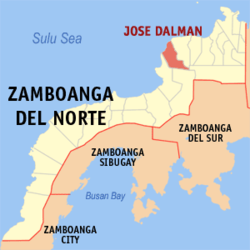Jose Dalman Ponot | |
|---|---|
| Municipality of Jose Dalman | |
| Nickname: The Pink Town | |
 Map of Zamboanga del Norte with Jose Dalman highlighted | |
Location within the Philippines | |
| Coordinates: 8°26′34″N123°01′19″E / 8.4428°N 123.0219°E | |
| Country | Philippines |
| Region | Zamboanga Peninsula |
| Province | Zamboanga del Norte |
| District | 2nd district |
| Founded | 1979 |
| Named after | Jose Cabilin Dalman |
| Barangays | 18 (see Barangays) |
| Government | |
| • Type | Sangguniang Bayan |
| • Mayor | Allen T. Ferrater (Lakas) |
| • Vice Mayor | Julieta J. Macapaz (Lakas) |
| • Representative | Irene G. Labadlabad (Lakas) |
| • Municipal Council | Members |
| • Electorate | 22,288 voters (2025) |
| Area | |
• Total | 135.00 km2 (52.12 sq mi) |
| Elevation | 78 m (256 ft) |
| Highest elevation | 390 m (1,280 ft) |
| Lowest elevation | 0 m (0 ft) |
| Population (2024 census) [3] | |
• Total | 27,951 |
| • Density | 210/km2 (540/sq mi) |
| • Households | 6,187 |
| Economy | |
| • Income class | 5th municipal income class |
| • Poverty incidence | 57.66 |
| • Revenue | ₱ 180.4 million (2022) |
| • Assets | ₱ 238 million (2022) |
| • Expenditure | ₱ 73.28 million (2022) |
| • Liabilities | ₱ 13.36 million (2022) |
| Service provider | |
| • Electricity | Zamboanga del Norte Electric Cooperative (ZANECO) |
| Time zone | UTC+8 (PST) |
| ZIP code | 7111 |
| PSGC | |
| IDD : area code | +63 (0)65 |
| Native languages | Subanon Cebuano Chavacano Tagalog |
| Website | josedalman |
Jose Dalman, officially the Municipality of Jose Dalman (Cebuano : Lungsod sa Jose Dalman; Subanen: Benwa Jose Dalman; Chavacano: Municipalidad de Jose Dalman; Tagalog : Bayan ng Jose Dalman), is a municipality in the province of Zamboanga del Norte, Philippines. According to the 2020 census, it has a population of 28,881 people. [5]



